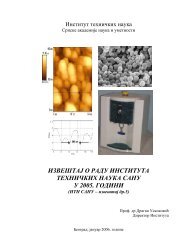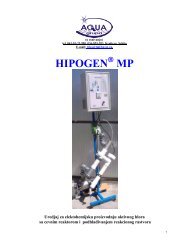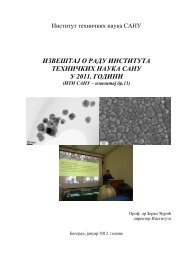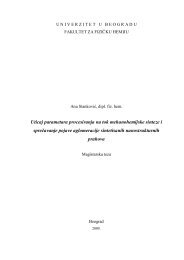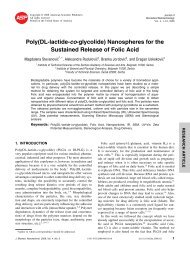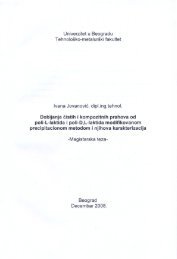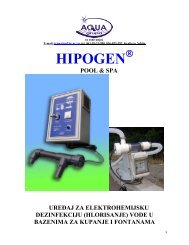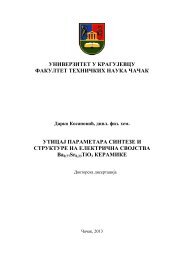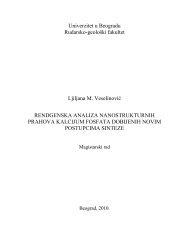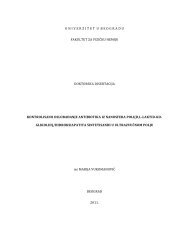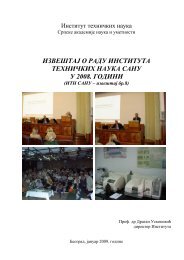Program and the Book of Abstracts (PDF) - Mrs-serbia.org.rs
Program and the Book of Abstracts (PDF) - Mrs-serbia.org.rs
Program and the Book of Abstracts (PDF) - Mrs-serbia.org.rs
You also want an ePaper? Increase the reach of your titles
YUMPU automatically turns print PDFs into web optimized ePapers that Google loves.
Tenth Young Researche<strong>rs</strong> Conference – Materials Science <strong>and</strong> Engineering<br />
December 21-23, 2011, Hall 2, SASA, Knez Mihailova 35 & 36, Belgrade, Serbia<br />
II/4<br />
Fullerenol C 60 (OH) 24 decrease DNA damages on human lymphocytes<br />
Jasminka Mrdjanović 1 , Slavica Šolajić 1 , Višnja Bogdanović 1 , Aleks<strong>and</strong>ar Djordjević 2 ,<br />
Gordana Bogdanović 1 , Rade Injac 3 , Zlatko Rakočević 4<br />
1 Oncology Institute <strong>of</strong> Vojvodina, Experimental Oncology Department, Sremska Kamenica, Serbia,<br />
2 Unive<strong>rs</strong>ity <strong>of</strong> Novi Sad, Faculty <strong>of</strong> Science, Department <strong>of</strong> Chemistry, Novi Sad, Serbia, 3 Faculty <strong>of</strong><br />
Pharmacy, Unive<strong>rs</strong>ity <strong>of</strong> Ljubljana, Ljubljana, Slovenia, 4 Institute “Vinča” <strong>of</strong> Nuclear Sciences,<br />
Belgrade, Serbia<br />
Fullerenol C 60 (OH) 24 nanoparticles (FNP), posses a great potential for biomedical application.<br />
We evaluated physicochemical properties <strong>of</strong> FNP in water <strong>and</strong> culture medium by measuring <strong>of</strong><br />
FNP number distribution <strong>and</strong> by atomic force microscopy (AFM). We also analyzed genotoxic <strong>and</strong><br />
antigenotoxic effects <strong>of</strong> FNP on human peripheral blood lymphocytes using micronucleus test.<br />
FNP number distributions <strong>and</strong> AFM showed that predominant particles were around 90 nm <strong>and</strong> 200<br />
nm respectively. Micronucleus assay revealed that FNP decreased micronucleus frequency on<br />
undamaged <strong>and</strong> mitomycinC-damaged lymphocytes at subcytotoxic concentration.<br />
FNP did not exhibit genotoxic but induced antigenotoxic effects at subcytotoxic concentrations<br />
on human lymphocytes.<br />
II/5<br />
The rabbit gingival tissue response to retraction liquids <strong>and</strong> tetrahydrozoline<br />
Ivan Kostić 1 , Dragan Mihailović 2 , Stevo Najman 1 , Sanja Stojanović 1 , Milena Kostić 3<br />
1 Unive<strong>rs</strong>ity <strong>of</strong> Niš, Faculty <strong>of</strong> Medicine, Institute <strong>of</strong> Biology <strong>and</strong> Human Genetics, Serbia,<br />
2 Unive<strong>rs</strong>ity <strong>of</strong> Niš, Faculty <strong>of</strong> Medicine, Institute <strong>of</strong> Pathology, Serbia,<br />
3 Clinic <strong>of</strong> Dentistry Niš, Department <strong>of</strong> Prosthodontics, Serbia<br />
The aim <strong>of</strong> <strong>the</strong> study was a comparative analysis <strong>of</strong> <strong>the</strong> effects <strong>of</strong> different retraction materials<br />
<strong>and</strong> tetrahydrozoline on gingival tissue. The research started from <strong>the</strong> assumption that<br />
tetrahydrozoline is a biologically more acceptable means <strong>of</strong> gingival retraction than commercially<br />
available preparations.<br />
The effect <strong>of</strong> retraction liquids on <strong>the</strong> basis <strong>of</strong> aluminum chloride <strong>and</strong> epinephrine, as well as<br />
alternative tetrahydrozoline hydrochloride on gingival tissue <strong>of</strong> rabbits was investigated. The<br />
application time in <strong>the</strong> rabbit’s gingival sulcus was seven minutes. The tissue biopsy was<br />
performed after one hour, one, seven <strong>and</strong> thirty days. Tissue preparations were analyzed<br />
histopathologically.<br />
Application <strong>of</strong> retraction liquids led to an acute inflammatory response which in time assumed a<br />
chronic character. Use <strong>of</strong> tetrahydrozoline resulted in a visibly weaker inflammatory response.<br />
8





